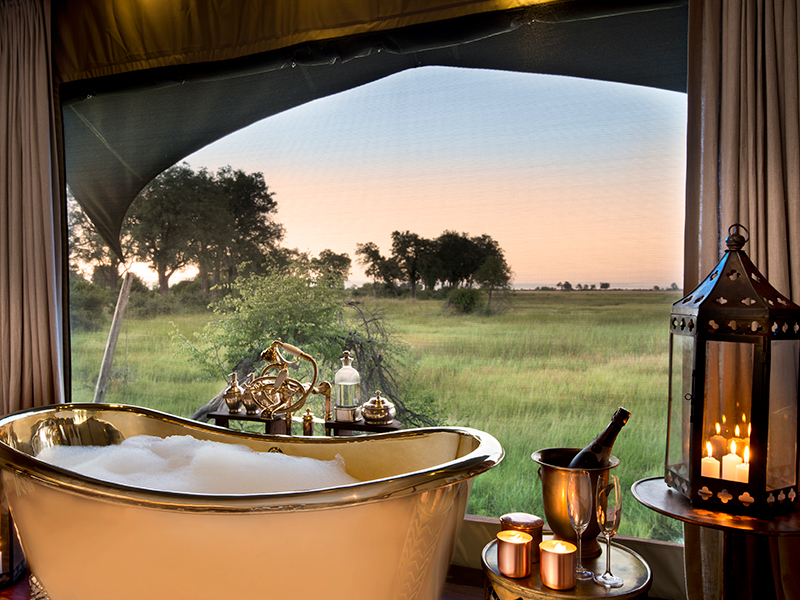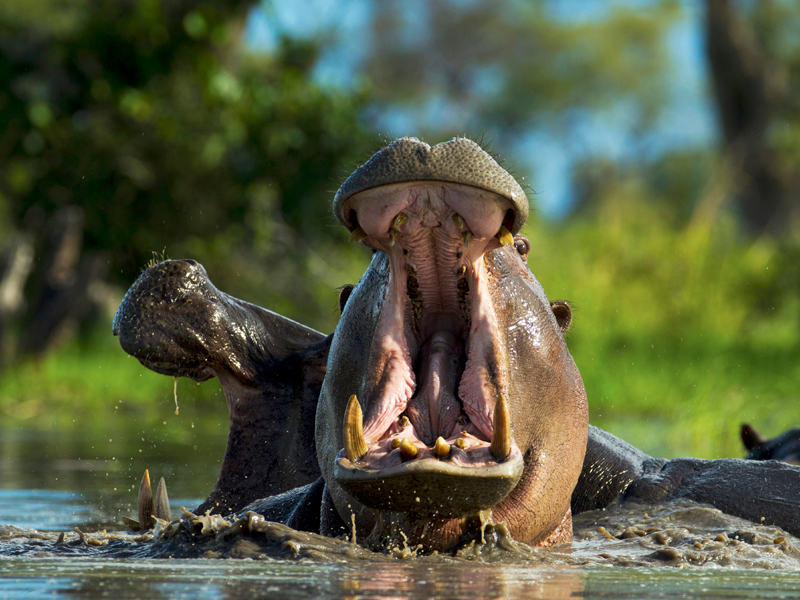About Botswana
Botswana is a diverse land of mighty rivers, the world’s largest inland delta teeming with wildlife, an ocean of salt pans resembling the surface of a far away planet, and the arid and unrelenting semi-desert of the Central Kalahari. Every corner of this intriguing country has something different to offer its visitors. Botswana is leading the trend for low-impact, eco-luxe tourism in Southern Africa, giving guests a true wilderness experience without sacrificing comfort or affecting the natural environment. The country is sparsely populated and localised, leaving a majority of Botswana wild and free for its original inhabitants and making it one of the finest safari destinations in Africa.
Close to 40% of the country is designated wildlife areas divided between National Parks, Game Reserves, and exclusive private concessions. Lodges in these areas typically only host up to 24 guests, so visitors are guaranteed personal attention and other tourists are few and far between. Due to this exclusivity, and the privacy that comes with it, Botswana is one of the highest demand locations to visit in Southern Africa, especially for the ultimate safari adventure in an unspoiled country.
Top Destinations in Botswana
- Okavango Delta: A remarkable inland delta, so large that can be seen from space.
- Chobe National Park: Boasting one of the largest elephant populations on the planet, this park is teeming with game and is a wildlife photographer’s paradise.
- Central Kalahari Game Reserve: Remote and secluded safari, excellent for spotting cheetahs and meerkats.
- Makgadikgadi Pans: An intriguing moonscape made entirely of salt; the Makgadikgadi Pans are a wide-open, flat vista that will leave you breathless.
- Kwando-Linyanti Area: Private concessions protecting an impressive amount of game and surrounded by intricate river systems.
Points of Interest
Okavango Delta:
The Okavango, declared a World Heritage Site in 2014, is Botswana’s most renowned destination. Encompassing 15,000 square kilometers of lush wetlands, savannas, river systems, private islands flanked with palm trees, and immaculate lagoons dotted with water lilies, this vast marshland of almost unfathomable size can actually be seen from space. The delta can only truly be appreciated from a local mokoro (or canoe), silently winding through her peaceful waterways, anxious about what you might come across at every bend of the intricate network of channels and streams. Large herds of elephant, buffalo, giraffe and various antelope are a common sighting in this area, as are predators such as lion, cheetah, leopard, and spotted hyena. Underneath its surface is an astounding amount of aquatic life, which attracts the African Fish Eagle, among 400 other species of birds.
Chobe National Park:
The Chobe River forms the northern boundary of this National Park, and of the country itself, between northern Botswana and the north-eastern panhandle of Namibia. Despite the plentiful water availability in the Okavango further south, this river is the only natural source of water for the park’s inhabitants. Large herds of elephant, buffalo and giraffe roam the open floodplain on the northern banks of the river, which opens up the flat and open savanna of the Caprivi Strip in Namibia. The road running along the Chobe gives way to a 180 degree vista that’s teeming with wildlife. Lions and leopard are also common sightings in this park, especially during the dry season. Since Botswana is in close proximity to Victoria Falls (located in Zimbabwe), this park does see a large amount of day visitors in addition to guests staying in lodges near the park. This does create a bit of high demand in-season around wildlife sighting in the more popular times of the year.
Central Kalahari Game Reserve
Vast, rugged, and at times unforgiving, the Central Kalahari is Botswana’s largest game reserve, making up 52,000 square kilometers. For most parts of the year, especially during peak dry season, the inhospitable habitat and climate does not support large amount of game. When the rains come in early December, however, the petrified river systems entice wildlife to its refreshing pans. Until quite recently, this reserve was closed to the public and still only houses 2 permanent camps within the park. It’s an excellent area for spotting cheetah, meerkats, black-mane lions, and a variety of smaller predators such as Cape and Bat-eared foxes, African wild cats and jackals.
Makgadikgadi Pans
This area is part of the Kalahari basin and forms some of the largest salt pans in the world. Despite is deceptive name, much of the Kalahari isn’t desert at all, but sprawling flats made up entirely of salt. Its main source of water, the Boteti River attracts game for hundreds of miles during the dry season. This area forms the western boundary of the park and is where most of the park’s accommodation is situated. The Makgadikgadi isn’t a top wildlife destination when compared to other parts of Botswana, but it does host the second largest Zebra migration in Africa. Its unique geological feature and stark landscape give guests the feeling of true isolation and freedom. Quad bike activities are offered during the dry season and are a different, fun way to experience this area.
Kwando-Linyanti Area
The private concessions of Linyanti, Kwando, Selinda as well as the Chobe Forest Reserve make up a large barrier of protection for wildlife and offer extremely exclusive safaris. The Kwando and Linyanti rivers form the natural border with Botswana’s neighbor to the west, Namibia. These rivers serve as a catchment area for the Okavango Delta, attracting large populations of game in the dry season. Selinda, to the south, is made up of dry savanna and grasslands which offer wide, open vistas for spotting the area’s plethora of predators during peak season. All of these areas, with their floodplains and river systems, mirror that of the Okavango Delta and are an oasis for abundant wildlife and birdlife.
Travel information
There are limited direct flights to Botswana, so it is best to book your international flight to O.R. Tambo in Johannesburg, then catch a smaller commercial flight to Windhoek as getting to your destination is typically done by small aircraft. It is not a destination for self-driving tourists, as everything is immensely spread out and most areas are inaccessible by road.
Visa Requirements:
- Entry permits can change, so best to contact your local Botswana Embassy before traveling.
- Passports must be valid for at least 6 months.
- All visitors must carry their onward or return airline ticket.
- Citizens from most countries staying less than 30 days do not require a visa and will receive an entry permit upon arrival.
Currency:
- The Botswana Pula is the official currency of the country, but camps will also accept US Dollars, Pounds, Euros and South African Rands.
- Credit Card facilities are common in the country but there are places where these aren’t accepted, so please be prepared to pay cash for some items.
Tipping:
As in most parts of the world, tipping is completely up to a guest’s discretion, and whether or not you were satisfied with the service provided.
- Who?
- Your guides and staff at a safari lodge.
- When?
- Amount?
- Guidelines: roughly $10 per guest for half-day activities, double for full-day excursions.
- Private Guides: $20 per guest per day.
- Lodge Staff and Mokoro polers: $5 per guest per day.
Seasonal Information
Botswana has a subtropical desert climate, defined by its difference in day and night temperatures. Its general climate is typical of a southern African country; with its rainy season occurring during the summer months of December – March. However, Botswana does get much less rainfall than neighboring its countries. Most of the country’s destinations are best visited during the dry season, but a few are better to witness at the start or middle of the rainy season.
January – March: Wet Season (Summer)
January and February are the wettest months during the year in Botswana, where torrential downpours can be expected most afternoons with high temperatures and high humidity. The rains lessen going into the month of March and the temperatures begin to cool, which is when tourist season begins to pickup.
April – May: End of the Wet Season
During this period, the rains have nearly subsided and temperatures are relatively cool in the morning and evenings, allowing for long days of adventure and exploring – whether it be through Game drives, mokoro experiences or site seeing.
June – August: Dry Season (Winter)
Although this period is in the winter, and the morning and evening temperatures are cool, it is still one of the best times to visit Botswana for a quieter tourist season. Make sure to pack warm winter clothing, as temperatures can drop below freezing in the night – especially in the dryer Kalahari areas
September – October: Dry Season (coming into Summer)
When the winter season passes and the summer season begins, the heat and humidity begin to build and temperatures can still be mild, but will increase in October. This is the perfect, and final, time during the year to experience the natural beauty of Botswana during the change of season.
November – December: Beginning of the Wet Season (Summer)
Even though the summer season has arrived, it brings with it clouds and rain rolling in. During this time Botswana experiences a drop the temperatures during afternoon showers, although expect to go through high humidity as well.
Botswana's Wildlife
Botswana represents one of Africa’s greatest conservation efforts, as the local government has put the protection and conservation of the country’s wildlife at the forefront of its agenda. This is evident in the amount of wildlife seen in nearly all parks and reserves in Botswana. Apart from the rhino, all of the major big safari animals are common sightings on a game drive or mokoro (canoe) safari, while the Okavango and Moremi areas in particular contain one of the largest populations of the endangered Wild Dog. Elephant, giraffe, buffalo, hippo, zebra, and wildebeest are all abundant, whilst guests are also likely to observe lion, leopard, cheetah and hyena.



